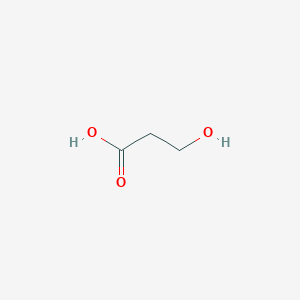|
3-Hydroxypropionic acid is a carboxylic acid. It is an intermediate in the breakdown of branched-chain amino acids and propionic acid from the gut. Typically it originates from propionyl-CoA and a defect in the enzyme propionyl carboxylase. This leads to a buildup in propionyl-CoA in the mitochondria. Such a buildup can lead to a disruption of the esterified CoA:free CoA ratio and ultimately to mitochondrial toxicity. Detoxification of these metabolic end products occurs via the transfer of the propionyl moiety to carnitine-forming propionyl-carnitine, which is then transferred across the inner mitochondrial membrane. 3-Hydroxypropionic acid is then released as the free acid. As an industrial chemical, it is used in the production of various chemicals such as acrylates in industry. When present in sufficiently high levels, 3-hydroxypropionic acid can act as an acidogen and a metabotoxin. An acidogen is an acidic compound that induces acidosis, which has multiple adverse effects on many organ systems. A metabotoxin is an endogenously produced metabolite that causes adverse health effects at chronically high levels. Chronically high levels of hydroxypropionic acid are associated with many inborn errors of metabolism including biotinidase deficiency, malonic aciduria, methylmalonate semialdehyde dehydrogenase deficiency, methylmalonic aciduria, methylmalonic aciduria due to cobalamin-related disorders, and propionic acidemia. Hydroxypropionic acid is an organic acid. Abnormally high levels of organic acids in the blood (organic acidemia), urine (organic aciduria), the brain, and other tissues lead to general metabolic acidosis. Acidosis typically occurs when arterial pH falls below 7.35. Infants with acidosis have symptoms that include poor feeding, vomiting, loss of appetite, weak muscle tone (hypotonia), and lack of energy (lethargy). These can progress to heart, liver, and kidney abnormalities, seizures, coma, and possibly death. These are also the characteristic symptoms of the IEMs mentioned above. Many affected children with organic acidemias experience intellectual disability or delayed development. In adults, acidosis or acidemia is characterized by headaches, confusion, feeling tired, tremors, sleepiness, and seizures. 3-Hydroxypropionic acid is also a microbial metabolite found in Escherichia, Klebsiella and Saccharomyces.
|
 click to show the details of this protein
click to show the details of this protein
 click to show the details of experiment for validating this pair
click to show the details of experiment for validating this pair

